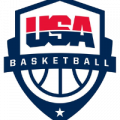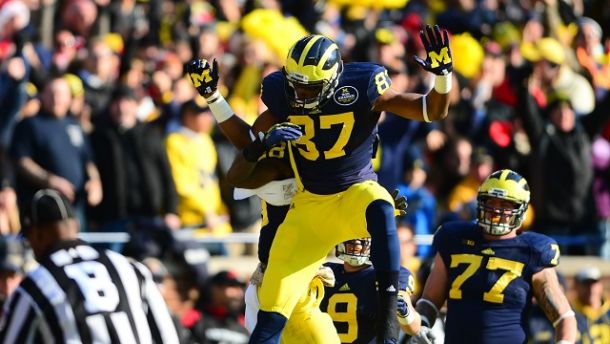With 910 wins to its credit, Michigan has won more games than any other program in the history of college football. They have also claimed 11 National Championships along the way, but haven’t truly fielded a team of National Championship relevance since 2006, when ranked #2 they lost the “Game of the Century” against #1 ranked Ohio State. The program has endured some lean times since that game, going 50-39 over the subsequent seven seasons, with the low point coming when they suffered consecutive losing seasons under Rich Rodriguez, Michigan hadn’t lost back to back seasons since 1962-63. Under Brady Hoke, the program has been going through a rebuilding phase and 2014, Hoke’s fourth season, promises to be a continuation of that process; the wait for a return to national significance looks like lasting a little longer.
2013 Michigan Wolverines Season
A routine victory over Central Michigan and an impressive win over Notre Dame helped Michigan get off to a 5-0 to start. However there were warning signs during that winning run as Michigan made hard work of wins over Akron (5-7) and UConn (3-9), turning the ball over four times in each game. Things really went wrong in November with the humbling by the Michigan State defense in East Lansing, followed by a similarly poor showing against Nebraska in Ann Arbor. In that two game span Michigan allowed 14 sacks and totaled -69 rushing yards, the offensive problems had come to a head. Michigan rallied against Ohio State, losing 42-41 at the Big House in one of the most entertaining games of the 2013 season, but it was too little too late. The season ended limply with defeat against Kansas State in the Buffalo Wild Wings Bowl.

Offense
Michigan responded to their 2013 offensive meltdown by hiring Doug Nussmeier in place of Al Borges as offensive coordinator. Both broadly fit under the “pro-style” banner but Nussmeier puts a greater emphasis on a physical downhill running style and has apparently simplified the offensive game plan.
In order for that to work Michigan must get better play from the offensive line, the unit won’t be great in 2014, but if they can coax an average performance from it, then it would be a marked improvement over the 2013 line. They will have to make that step forward without Taylor Lewan and Michael Schofield, the long term starters at left and right tackle, respectively. There is talent available and the players who struggled on the interior in 2013 have had another year of physical development and coaching under their belts will be better for the playing experience gained in 2013. Sophomore Erik Magnuson and freshman Mason Cole are the main contenders to replace Lewan at LT.
The starting quarterback has yet to be named, but in all likelihood Devin Gardner will be back under center. Gardner has the size, arm strength, and athleticism to be a terrific college player, but his accuracy (60.3%) needs work. In addition, he seemed to struggle breaking down the defense and identifying the open receiver, problems that were exacerbated behind a porous offensive line. If Gardner is slow to adjust to the new offense, then either Shane Morris or Wilton Speight could challenge for the starting role. However, few quarterbacks can play well if they are exposed to the level of physical punishment Gardner was forced to endure in 2013, yet he struggled on, playing superbly while clearly injured against Ohio State. That performance alone should at least earn him the opportunity to show what he can do on the field again in 2014.
Although Gardner’s primary target Jeremy Gallon has moved on to the NFL, former tight end Devin Funchess returns and will play wide receiver full time in 2014. Funchess has the size, 6’ 5” and 230 lbs, and speed to be a constant mismatch, but he needs to show more consistent hands. Funchess has the support of a young and talented group of receivers, a description that could also be applied to the running backs. There, sophomores Derrick Green, De’Veon Smith, and if the NCAA is unusually kind, Ty Isaac should share the load. Neither Green nor Smith distinguished themselves in 2013, but they are talented, possess the size, and power to feature in Nussmeier's physical ground attack and much is expected of them in 2014.
Defense
Under defensive coordinator Greg Mattison, the Michigan defense has been stout and well coached, but lacking a bit in playmaking talent. However, they have recruited well and that talent has slowly filtered into the lineup. Mattison has made some changes for 2014, changing up coaching responsibilities, transitioning the base defense from a 4-3 under to a 4-3 over, and moving star linebacker Jake Ryan into the middle. Ryan, a very instinctive linebacker, tore his ACL during spring practices last season, but made a remarkable recovery to be back playing by mid-October. He should be at full speed this time around and will be key to the success of the 2014 Michigan defense. Ryan will be flanked by experience, with James Ross and Desmond Morgan outside him, and that trio have talented depth behind them.
The defensive line is also starting to look deep, both inside and outside. The fitness of powerful defensive tackle Ondre Pipkins remains a concern, but they are far better placed to cope without him in 2014 than they were in 2013 and in Willie Henry they have a potential breakout star on the inside. The line flashed pass rush talent in 2013, but were unable to consistently get to the quarterback, but they return Frank Clark, Brennen Breyer, Taco Charlton, and Mario Ojemudia, all of whom will expect to have more of an impact in 2014.
If the pass rush improves that will benefit the secondary. There is plenty of returning experience and a fair amount of talent at cornerback with Blake Countess (tied for the lead Big Ten with 6 interceptions), Raymon Taylor, Jourdan Lewis, and star incoming freshman Jabrill Peppers. The bigger issue comes at safety which was the weakest point of the defense in 2014. Jarrod Wilson gained some starting experience in 2013 and is a front runner to take one starting position, but the fight will be on through the fall for the second starting spot, it could go to Delano Hill, Dymonte Thomas, or perhaps Peppers.
Special Teams
Matt Wile has been the long distance kicking option for the past two seasons. He has only completed 62.5% of his field goal attempts, but that isn’t unexpected from that sort of range. Wile will likely backup Will Hagerup at punter, as Hagerup returns from a season-long suspension. The fleet footed Dennis Norfleet was the primary return man in 2013 and will be heavily involved in special teams again this season. Norfleet is likely to be joined by some of the freshman. Returning kicks and punts would be an exciting way to get the ball into Peppers' hands.
2014 Season Outlook
The season opens with Michigan hosting Appalachian State, reviving memories of the Mountaineers famous victory in the Big House back in 2007. Thankfully for the Wolverines, this is not the same Appalachian State team and a repeat upset seems unlikely. Utah and Penn State are probably the toughest teams on a relatively straightforward looking home slate of games. However, Michigan is somewhat unfortunate in that they must go on the road to face their three strongest opponents, with visits to Notre Dame, Michigan State, and Ohio State on the schedule.

On paper, the 2014 Wolverines look like an 8 or 9 win team, which fits what the schedule offers, though if they can start the season strong and pull off an upset in South Bend they could arrive in East Lansing an impressive 7-0. There has been some talk of Brady Hoke being on the hot seat, but so long as the 2014 record is respectable, and they avoid a repeat of last season’s embarrassing offensive meltdown, Hoke should survive through to 2015 when the roster will be entirely Hoke’s and the schedule looks favorable.








































